
Chlorophytum comosum, usually called spider plant or common spider plant due to its spider-like look, also known as spider ivy, ribbon plant, and hen and chickens is a species of evergreen perennial flowering plant of the family Asparagaceae. It is native to tropical and Southern Africa but has become naturalized in other parts of the world, including Western Australia and Bangladesh. Chlorophytum comosum is easy to grow as a houseplant because of its resilience, but it can be sensitive to the fluoride in tap water, which commonly gives it "burnt tips". Variegated forms are the most popular.
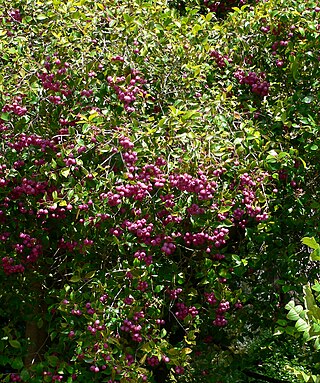
Syzygium smithii is a summer-flowering, winter-fruiting evergreen tree, native to Australia and belonging to the myrtle family Myrtaceae. It shares the common name "lilly pilly" with several other plants.It is planted as shrubs or hedgerows, and features: rough, woody bark; cream and green smooth, waxy leaves; flushes of pink new growth; and white to maroon edible berries. Unpruned, it will grow about 3–5 m (9.8–16.4 ft) tall in the garden.
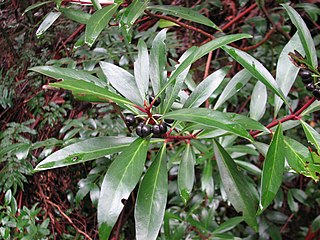
Tasmannia lanceolata, commonly known as Tasmanian pepperberry or mountain pepper, is a shrub native to woodlands and cool temperate rainforest of south-eastern Australia. The shrub varies from 2 to 10 m high. The aromatic leaves are lanceolate to narrow-elliptic or oblanceolate, 4–12 cm long, and 0.7–2.0 cm wide, with a distinctly pale undersurface. Stems are quite red in colour. The small cream or white flowers appear in summer and are followed by black, globose, two-lobed berries 5–8 mm wide, which appear in autumn. There are separate male and female plants.

Carissa spinarum, the conkerberry or bush plum, is a large shrub of the dogbane family (Apocynaceae), widely distributed in tropical regions of Africa, Southern Asia, Australia, and various islands of the Indian Ocean. It is most well known in Australia, where it is also called currant bush or, more ambiguously, native currant or even black currant. It is, however, neither closely related to plums (Prunus) nor to true currants (Ribes), which belong to entirely different lineages of eudicots. In India, it is also called wild karanda /wild karavanda, referring to the related karanda. Carissa spinarum is often discussed under its many obsolete synonyms.

Chionanthus ramiflorus, commonly known as northern olive or native olive, is a species of shrubs and trees, of the flowering plant family Oleaceae. They grow naturally in India, Nepal, northeastern Australia (Queensland), New Guinea, the Philippines, southern China and Taiwan.

Pouteria australis, also known by the synonym Planchonella australis, is a medium to tall rainforest tree of the family Sapotaceae native to Queensland and New South Wales, Australia. It is known by the common name black apple, wild plum, yellow buttonwood, black plum and yellow bulletwood.

Geitonoplesium is a monotypic genus in the family Asphodelaceae, containing the sole species Geitonoplesium cymosum, commonly known as scrambling lily. The species is a perennial evergreen scrambling vine found in rainforests, sclerophyll forests and woodlands of eastern Australia, and parts of Malesia and Melanesia.
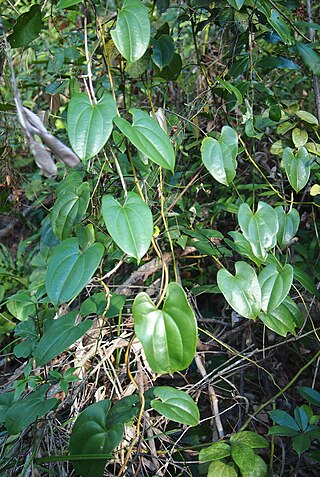
Dioscorea transversa, the pencil yam, is a vine of eastern and northern Australia.

Buchanania arborescens, commonly known as little gooseberry tree or sparrow's mango, is a small and slender tree native to seasonal tropical forests of northern Australia, south-east Asia, and the Solomon Islands.
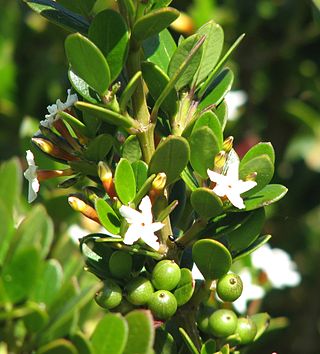
Alyxia buxifolia, otherwise known as the sea box or dysentery bush, is a species of evergreen shrub in the family Apocynaceae.
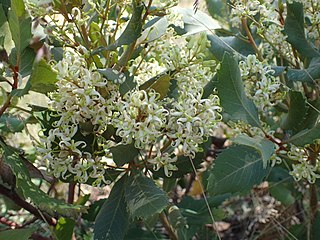
Lomatia fraseri, commonly known as tree lomatia, forest lomatia or silky lomatia is a plant of the family Proteaceae native to eastern Australia. It grows as a shrub or small tree, reaching 8–11 metres (26–36 ft) high, with highly variable leaves. The cream to white inflorescences appear over summer. It is found in rainforest margins, gullies and heathland in mountainous regions of Victoria and New South Wales. It regenerates from fire by regrowing from a lignotuber.

Elaeocarpus bancroftii, commonly known as Kuranda quandong, Johnstone River almond, ebony heart, grey nut, or nut tree is a large rainforest tree in the family Elaeocarpaceae which is endemic to Queensland. It has coriaceous leaves, attractive white flowers and relatively large fruit containing an edible kernel.

Atractocarpus chartaceus, commonly known as the narrow-leaved gardenia, is a species of evergreen flowering plant in the madder and coffee family Rubiaceae. It is mostly found in subtropical rainforest of eastern Australia, and it is cultivated for its fragrant flowers and colourful fruit.
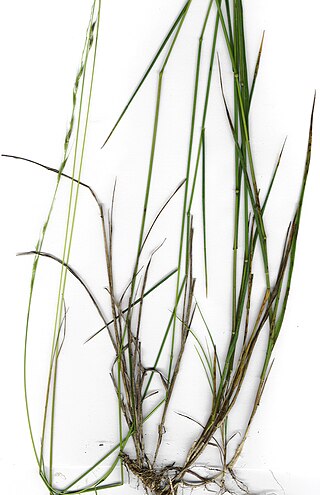
Microlaena stipoides, synonym Ehrharta stipoides, is a species of grass. It occurs naturally in all states of Australia as well as in New Zealand, Papua New Guinea, Indonesia and the Philippines. It has also been introduced into Hawaii and Reunion Island and has been reported as invasive in both. Common names used include weeping grass, weeping rice grass and weeping meadow grass.

Astroloma humifusum, commonly known as the native cranberry or cranberry heath, is a small prostrate shrub or groundcover in the heath family Ericaceae. The species is endemic to south-eastern Australia.

Myoporum acuminatum, commonly known as waterbush, pointed boobialla or mangrove boobialla, is a flowering plant in the figwort family Scrophulariaceae and is endemic to eastern Australia. It grows in rainforest or wet eucalyptus forest near the coast and in the Coastal Ranges, and is occasionally associated with mangroves. Occasionally it is found in the drier rainforests. It grows naturally as far south as Mimosa Rocks National Park in far south eastern New South Wales, and north to Fraser Island in Southern Queensland.

Vincetoxicum barbatum, synonym Tylophora barbata, the bearded tylophora, is a small vine in the dogbane family. A common plant found south of Bulahdelah, New South Wales. The habitat is rainforest and moist eucalyptus forests in south eastern Australia. Not often seen in flower, but flowers are dark red, around 7 mm long on thin stalks. Broken branches produce watery or milky sap.

Exocarpos latifolius is a species of parasitic tree, in the plant family Santalaceae. They have the common names broad leaved ballart, scrub sandal-wood, scrub cherry, oringorin, broad leaved cherry or native cherry. The species is found in monsoon forest, littoral rainforest and occasionally in more open forest types in Malesia and across Northern Australia.

Ehretia saligna, commonly known as peach bush, native willow and peachwood is a species of shrubs or small trees, endemic to Northern Australia. The natural range extends from the Gascoyne, across the Northern Territory throughout northern Queensland and coastal; regions of Southern Queensland and New South Wales.

Myristica insipida, commonly known in Australia as Australian nutmeg, Queensland nutmeg or native nutmeg, is a small rainforest tree in the family Myristicaceae native to parts of Malesia, Papuasia and Australia. It is closely related to the commercially-important species of nutmeg, M. fragrans.






















